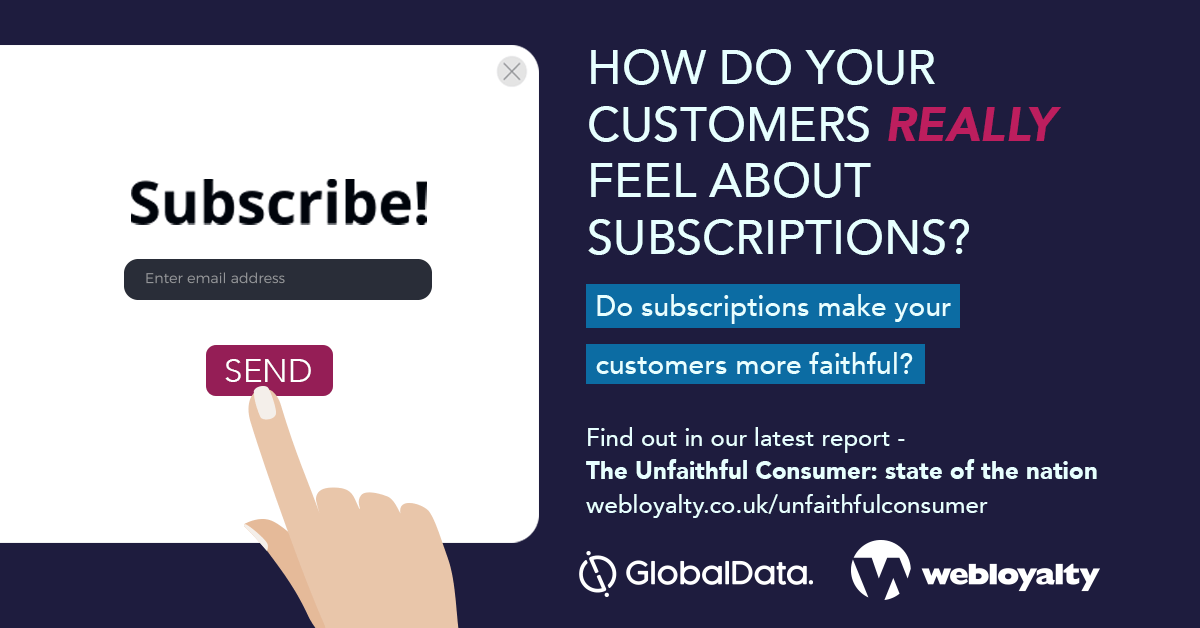Richard Piper, our Business Development Director discusses the thriving sector of subscription based services and how offering a paid for loyalty programme can drive customer retention.
The question all retailers ask themselves, what is the key to customer loyalty? Cultivating long term relationships with your customers is vital to the success of most businesses.
However consumer loyalty to brands is tumbling across the sector with over 60% of consumers shopping around at more retailers than they were five years ago, the cost of this consumer deflection for retailers rising to £147.2 billion this year.
According to the recently published report carried out by us, The Unfaithful Consumer 2, perhaps unsurprisingly price is the number one driver in store choice, in fact most retail sectors now have a consumer loyalty rating of less than 50 percent. Considering it’s so easy to shop around and find a better deal, it’s not surprising loyalty is at an all-time low. Retailers need to work harder than ever to persuade customers to shop with them over competitors. However, one sector is bucking the general trend of consumer disloyalty: subscription services are thriving.
Technology’s disruptive influence over traditional retail processes has ultimately steered the shift from offline to online shopping; we have seen exceptional change in the behaviours of consumers. Busy lifestyles and deal-savvy shoppers mean convenience and value for money have become a primary influencer on where they choose to shop and many subscription services offer these benefits.
Between 2014 to 2017, membership to subscription websites like Dollar Shave Club and Birchbox grew by a reported 800 percent, while research carried out our report The Unfaithful Consumer 2 shows that 47 percent of all UK consumers are signed up to at least one subscription service. In fact, according to the study, subscription users are signed up to an average of 2.7 programmes with entertainment leading the way.
Subscription services getting personal
When a consumer signs up to Spotify, they are immediately given access to a vast mountain of music. Personalisation is introduced from the start as Spotify’s algorithms suggest to each user artists they may like, music they may not have heard before and alerts for new releases from related bands, all based on listening behaviours.
This personalised approach reflects the fact that 55 percent of all subscription packages are “curation-based” and speak directly to the unique consumer. Indeed, 28 percent of subscribers say that “an excellent personalised experience is the most important reason to continue their subscriptions.”
Food subscription brand Graze uses personalised boxes to fit the lifestyles and tastes of different consumers. With a huge variety of different snacks available allowing consumers to build bespoke boxes according to their desires. Graze also use the huge amount of data at their disposal to ensure that the choices that they send out to customers deliver to their tastes – ensuring even greater retention rates to their subscription model.
The entertainment industry, through brands like Netflix, Now TV and Apple Music, is leading the way for paid subscription packages. Indeed, Webloyalty found that almost two-thirds of subscription members are users of entertainment packages. Just over 10 years ago Netflix reported 7.5m members, now membership is reported to be over 93m.
Netflix’s focus on personalised approach makes consumers a feel appreciated as individuals with movie and television suggestions sent directly to them based on their own viewing behaviours. This creates a value for the consumer, allowing them to discover new movies and shows, bolstering Netflix’s role in their lives.
Convenience and benefits are key
Subscription packages must offer quality benefits and convenience to the consumer to be successful. According to Webloyalty’s The Unfaithful Consumer 2 report, “free online delivery” and “convenience of knowing that the goods or services will happen on a regular basis” are the two most important features of any subscription service.
The incredible success of Amazon Prime is an example of how convenience and benefits provide an irresistible package that meets consumer’s needs so well that they are willing to pay more.
And pay more they do. For a £79 upfront per year, Amazon Prime offers free delivery on all products, streaming media, discount days and exclusive deals, among other benefits. In the U.S., the average Prime member spend nearly double the amount on the site as non-members, illustrating that when rolled out properly, subscription is an incredible driver of loyalty and customer retention. Amazon’s Alexa can also provide reminders of when to purchase mundane items like household goods, creating extra convenience for the consumer and promoting return purchasing for Amazon. With unparalleled loyalty this simple subscription service allows Amazon to open up a whole echo system powered by voice and search and this is proven by their retention rate of over 90%.
Does ‘locking in’ customers achieve true loyalty?
An integral part of the subscription loyalty boom is the ‘locking in’ of consumers. This is what many major subscription brands – from Dollar Shave Club to Graze and now to Uber – have found.
Uber’s new Ride Pass (currently only available in certain U.S. cities) offers consistently low prices and savings on trips for a flat monthly fee of $14.99. The Ride Pass promises lower monthly costs for customers who use the app frequently rather than switching between Uber and a competitor. Importantly for Uber, the Ride Pass also guarantees repeat business by ‘locking in’ the customer.
Dan Bilen, Uber’s Product Manager, told The Verge that: “We’re really keen to make sure this is priced to the point where people can buy the pass and not have to think too much about it.”
Like Amazon Prime, Uber intends to become an integral part of the user’s lifestyle, whereby the pros of paying a small, regular cost far outweigh any potential barriers.
Subscription services offer irresistible value
Brands are aware that some customers may not want to sign up for an annual membership to a service that they have yet to properly try-out. Brands are combating this concern by offering free trials or, in the case of Graze, halving the price of the first three orders. Brands give consumers a taste of what it’s like to experience a premium, hassle free subscription service.
While payment flexibility remains a potential barrier to subscription packages, brands are learning to overcome these obstacles. For example, the Dollar Shave Club has a “Not so Hairy” option that allows users to skip blade buying for a month. While the company may miss out on a month of revenue, retaining the customer long term is far more valuable.
Brands could make themselves irresistible – combining flexibility with convenience, offering value for money and rewarding customers for continuous custom are fundamental to building true customer loyalty.

